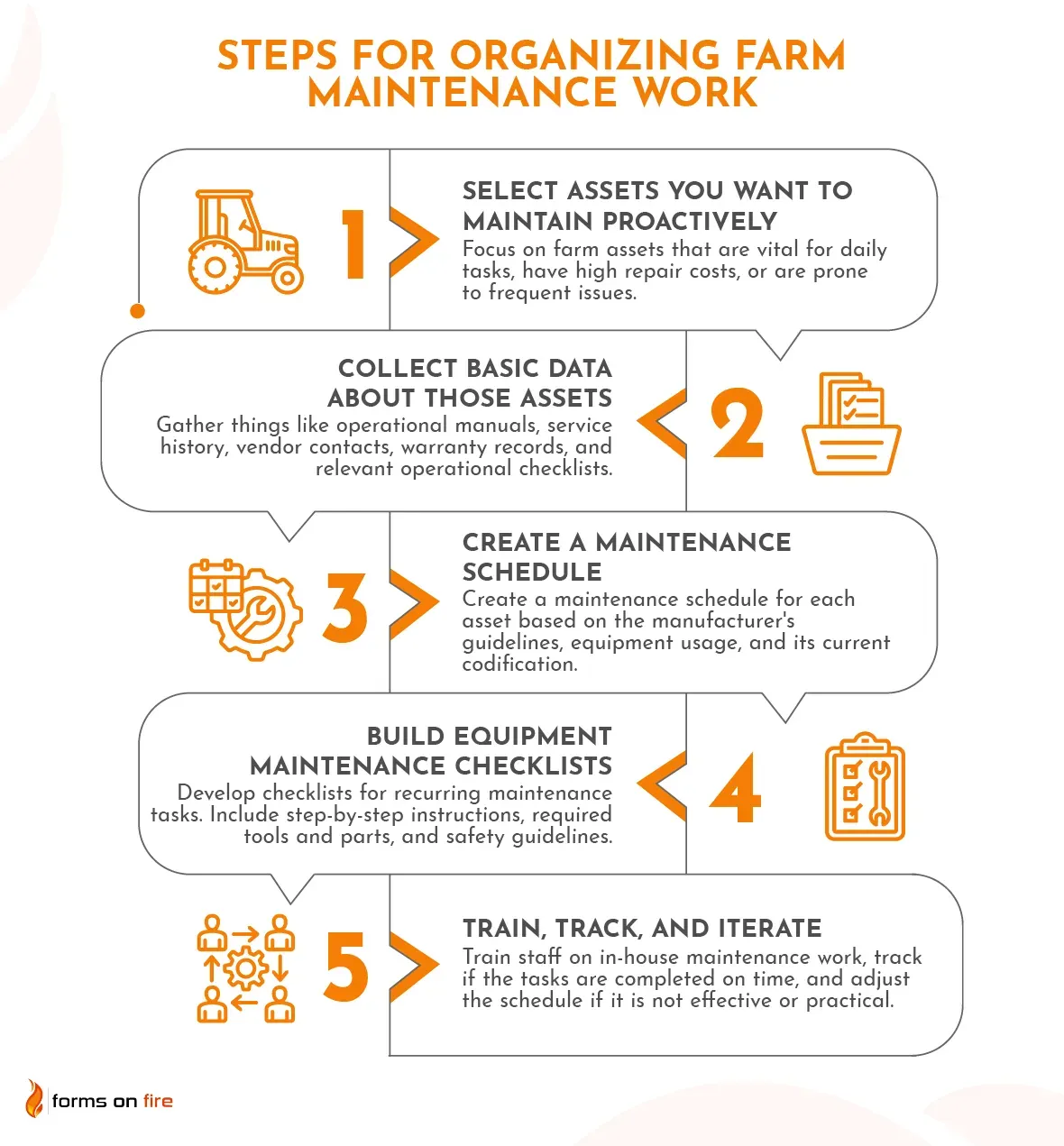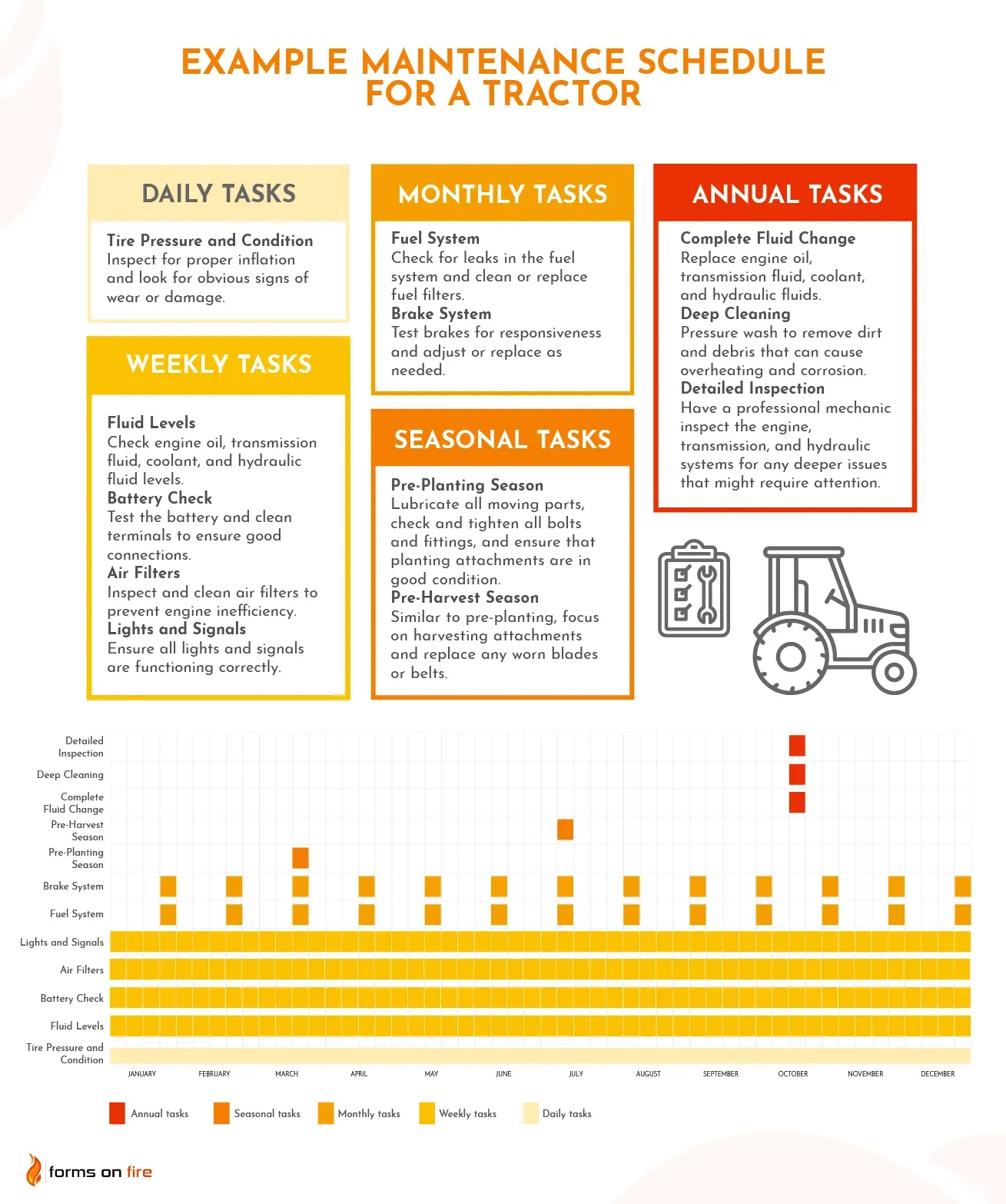How to Organize and Streamline Farm Maintenance Work
The goal of effective farm maintenance is to ensure that farm infrastructure, machinery, and tools stay in good operating condition year-round. Be it hen houses, tractors, or irrigation systems, proactive maintenance can prevent costly repairs and downtime — and provide peace of mind.
Let’s see how to set up a maintenance routine that will help keep your farm running smoothly and sustainably.
The scope of farm maintenance
Farm maintenance is a core part of farm management and encompasses a wide range of proactive and reactive activities. This includes the upkeep of various types of assets, such as:
- Machinery and vehicles: Tractors, harvesters, sprayers, and utility vehicles.
- Buildings and structures: Barns, greenhouses, storage silos, and animal shelters.
- Irrigation systems: Pumps, pipes, and sprinklers.
- Tools and equipment: Hand tools, power tools, and other specialized agricultural implements.
- Technology systems: Farm management software, sensors, and automated systems.
The benefits of regular, proactive farm equipment maintenance are huge:
- Reduced downtime: Regular checks and repairs mean fewer unexpected breakdowns.
- Cost efficiency: Preventive maintenance extends asset lifespan and is generally less expensive than major repairs or replacements.
- Improved safety: Well-maintained equipment poses fewer risks to operators and workers.
- Enhanced productivity: Equipment in good working condition operates more efficiently and effectively.
- Asset value preservation: Regular upkeep maintains or improves the resale value of farm equipment and infrastructure.
A common issue we see is farmers and farm managers looking at maintenance strictly as a cost center. When you think like that, your main focus is reducing those costs.
That is the wrong way to go about it. A better approach is to look at farm maintenance as an investment, with a potential for big returns in the long run.
That said, a farm is a business and you want to be smart about your investments. With that in mind, let’s see how to effectively organize and structure your farm maintenance work.
How to organize farm maintenance work
Organizing farm equipment maintenance is not just about fixing things when they break; it's about creating a systematic approach to prevent breakdowns in the first place.
Here's how you can set up an effective maintenance routine for your farm equipment:

Step #1: Select assets you want to maintain proactively
Start by identifying which pieces of equipment are critical to your farm operations. Focus on those that are vital for daily tasks, have high repair costs, or are prone to frequent issues.
This might include your main tractor, irrigation system, combine harvester, etc. The goal is to prioritize assets that, if they fail, would significantly impact your farm’s productivity.
Step #2: Collect basic data about those assets
Gather all necessary information about each piece of equipment you plan to maintain. This includes things like:
- Operational manuals: Keep a file with the manuals, as they often contain crucial maintenance schedules and procedures.
- Service history: Compile all maintenance activities and repairs for future reference, which will help in predicting future maintenance needs.
- Vendor contacts: Maintain a list of contact information for quick access to parts suppliers and repair services.
- Maintenance and safety checklists: Gather any pre-existing maintenance and safety checklists you might be using.
You can source this data from purchase records, warranty cards, and maintenance logs hiding in some filing cabinets. If it is not already in that format, we highly recommend creating digital versions of all of those documents. This will make them easier to store, update, and share.
Step #3: Create a maintenance schedule
The next step is to establish a maintenance schedule for each asset. To do that, consider the following:
- Manufacturer’s guidelines: Adhere to the manufacturer’s recommended service intervals.
- Equipment usage: The more you use the equipment, the more regular maintenance it will need — and vice versa.
- Seasonal preparation: Schedule detailed maintenance checks ahead of high-demand seasons to prevent unwanted surprises.
A typical maintenance schedule will include regular inspections, service intervals, and specific maintenance tasks like oil changes or blade sharpening.

Utilize calendar reminders or farm management software like Forms On Fire to keep track of scheduled tasks and ensure they are completed on time.
Step #4: Build equipment maintenance checklists
Develop detailed checklists for recurring maintenance tasks you perform in-house. Ideally, the information provided should include:
- Step-by-step instructions: Provide clear, detailed steps for the task at hand (inspection, cleaning, part replacement, troubleshooting) to ensure consistency and thoroughness.
- Required tools and parts: List necessary tools and parts needed for each task to ensure everything is on hand before starting the work.
- Safety protocols: Outline required safety checks and PPE to protect your team while performing maintenance work.
These checklists can be laminated and kept with the equipment or integrated into a mobile app for easy access.
Step #5: Train, track, and iterate
Train your staff on the importance of maintenance and how to properly execute the tasks listed in your checklists. Regularly track the completion of maintenance activities and the effectiveness of the current schedule. Be open to making adjustments based on what isn’t working.
Lastly, encourage feedback from people performing maintenance work and adapt your practices and maintenance schedules based on their insights.
Farm equipment maintenance best practices
Effective maintenance of farm equipment isn't just about following a schedule; it involves cultivating practices that ensure the reliability of your machinery.
Be proactive and consistent
Being proactive means addressing potential issues before they become actual problems, thus avoiding costly repairs and downtime. Here are key tasks that should be part of your regular maintenance routine:
- Oil changes: Regular oil changes are crucial for engine health. Use the manufacturer's recommended oil type and change intervals.
- Lubrication: Regularly lubricate moving parts to reduce wear and tear. Each piece of equipment will have its lubrication points and recommended lubricants.
- Cleaning: Dirt and debris can cause overheating and parts malfunction. Clean your machinery after use, focusing on removing debris from radiators and air intake systems.
- Inspections: Conduct thorough inspections of all equipment regularly to check for any signs of deterioration, such as cracks, excessive wear on tires, or hydraulic leaks.
Make sure the equipment is operated and used as intended
Ideally, you use farm equipment for its intended purpose and within its operational limits. Train your staff on the proper use of each machine, emphasizing:
- The limitations of each piece of equipment: For example, if you’re using a high-capacity sprayer, it's important to know the maximum tank capacity and optimal spray settings for different pesticides.
- The correct start-up and shut-down procedures as recommended by the manufacturer: For instance, when operating a diesel-powered generator, always check that the fuel system is pressurized before starting the engine to prevent air from entering and damaging the fuel pump. Shut-down procedures could include allowing the engine to idle for a few minutes to cool down before turning it off.
Keep select replacement parts and materials in stock
Minimize downtime by having critical replacement parts and materials readily available. Focus on parts that are most likely to wear out or fail, such as:
- Filters (air, oil, fuel): Keep a good stock of filters to avoid any interruptions during peak operational periods.
- Belts and hoses: These can degrade over time and with usage, so having spares can quickly resolve maintenance issues without waiting for parts to be delivered.
- Bearings and seals: Frequent wear items in heavy machinery due to constant pressure and movement.
- Electrical components: Items like fuses, bulbs, and wiring harnesses can fail unexpectedly and are essential for the safe operation of equipment.
To stay on top of your spare parts inventory, consider digitalizing your inventory management.
With Forms On Fire, you can build a digital system that allows for real-time updates on which parts are used, how many remain in stock, and when it is time to reorder. Furthermore, you can set up automated alerts when you reach minimum stock levels, as well as maintain detailed records for cost tracking and inventory forecasting.
Store farm equipment properly
Proper storage of farm equipment can significantly extend its service life and reduce maintenance costs. Consider:
- Weather protection: Store equipment in a covered area to protect it from weather extremes, which can cause rust and degradation.
- Clean before storing: Always clean equipment thoroughly before storing it long-term. This prevents corrosion and keeps pests out.
Document your maintenance work
Keeping detailed records of all maintenance activities is crucial for several reasons:
- Maintenance history: Helps in tracking the frequency of maintenance and identifying recurring issues. A detailed history can also be very useful for finding root causes of equipment failures and creating more effective maintenance schedules.
- Warranty claims: Detailed records can be required to process warranty claims.
- Resale value: A well-documented maintenance history can increase the resale value of your equipment.
Again, this is way easier to accomplish with a digital system.
For example, you can use Forms On Fire to create a maintenance work order with a specific due date and assign it to a maintenance technician or an operator. When they perform the task, they can reopen the work order on their mobile device and log things like the time taken and parts spent. They can even leave special notes before marking the task as done.
Streamline farm equipment maintenance with Forms On Fire
Forms On Fire is a custom app and form builder that you can use to digitalize any process or task on your farm.
In other words, you can use our platform:
- As your fully customized farm management software
- To digitize specific inspections, farm audits, maintenance scheduling, inventory control, or any other process you want to streamline.
We have a huge list of pre-built applications and forms for farmers so you do not have to design almost anything from scratch. Here are just some examples of existing templates in our database:
- Food Traceability app to support FSMA 204
- Feed Mill Inspection
- Feed Mill Inventory
- Hen House Checklist
- Hatchery Inspection
- Animal Movement Record
- Quality and Food Safety Training
- Water Hardness Testing
- Barn Audit
- Barn Inspection
- Inventory Tracking
- Map of inventory
- Pest Control Compliance Monthly Audit
- Food Safety Form
- Guard Shack Inspection
- In/Out Visitor Log
- Egg Count form
- Flock Records
- Animal Welfare Audit Tool
- Breeder Farm Audit
- Broiler Farm Audit
- Farm Audit Reports
- Veterinary Services Report
If you’re looking to digitize farm equipment management, let’s build you a custom solution that fits into existing workflows on your farm.
Learn more by taking a free trial or scheduling a product demo.




